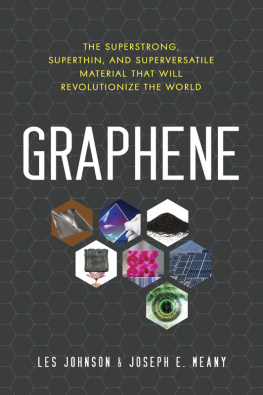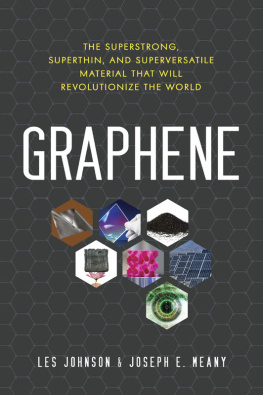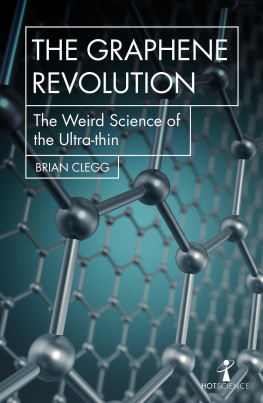The authors would like to thank our agent, Laura Wood of FinePrint Literary Management, for giving us the opportunity to write this book. Her text asking, What do you know about graphene? began a two-year-long odyssey to the work that is in your hands. We value the editors at Prometheus (Sheila Stewart and Hanna Etu) for the many suggested improvements they recommendedreaders everywhere should appreciate good editors! We would also like to thank Dr. Robert Hampson, aka Speaker to Lab Animals, for his help with understanding the brain science of . We would like to also thank the Atlanta-Fulton Public Library System for their assistance in obtaining research materials. Finally, deep appreciation must be expressed of Mother Nature, for giving us this wonderful universe to exploreand write about!

What is next for graphene? How will this potentially revolutionary material transition from university laboratories to the market and then on to changing the world? The answer is not easy. There are those who reside in the build it and they will come category. These folks have an unshakable belief in the marketplace of ideas and market-driven economics. If the product is superior to the competition and its price is competitive (or low), then people will buy it and make the technology successful. There is a great deal of truth in this belief, and, at least on the surface, history seems to support this viewpoint; good new ideas can often become successful in the marketplace for exactly these reasons. The smartphone is a great example. No one was asking for an iPhone, but once people saw the capabilities offered by one they could not imagine doing without it. Smartphones are now considered one of the most successful product innovations in history, and they were quickly adopted around the developed world.
Even if build it and they will come is the correct analog for the development of graphene-based products, then there is still the problem of building it. A cheap, efficient, and high-volume mass production system has not been successful to date. Likewise, early entrants into the graphene market have resisted efforts to standardize easy and cheap analysis methods, so there is not yet a reliable source for the raw material that might be used in graphene-enabled or enhanced products. Fortunately, various companies, nongovernmental organizations, and research institutions are certainly working to make that happen. When it does eventually occur, customers will finally be able to most accurately assess what product they will need. In this approach, there will likely be multiple suppliers competing for sales, each offering slightly different types of graphene and of varying quality.
Rather than rely on seemingly-random market forces, some countries are making conscious efforts to foster graphene-related research through financial resources devoted to development and innovation. This is being done through grants and contracts, tax incentives, and various other methods that governments have at their disposal for fostering innovation. Most notable in this category is the National Graphene Institute in Manchester, England. The institute, funded with over 38 million from the UK Government and 23 million from the European Regional Development Fund, is a partnership of over forty companies working with researchers from the University of Manchester toward making the graphene revolution happenwith UK companies as the primary beneficiaries. Their soon-to-open Graphene Engineering Innovation Centre will increase their overall research capabilities and bring in even more collaborators. The University of Manchester appears to be the focus of graphene research within Europe.
In 2013, China established their own institute, the China Innovation Alliance of the Graphene Industry (CGIA). CGIA, like most Chinese research consortia, is not as well-known as its European or American counterparts, but it is nonetheless a graphene research, development, and commercialization powerhouse.
What about the United States? For the most part, graphene research and development in the United States is decentralized and only loosely coordinated by the various government laboratories, universities, and commercial companies performing graphene research. To make the coordination of American efforts easier, the National Graphene Association (NGA) was formed in 2017. NGA's goal is to help American innovators get their graphene-related products to market as quickly as possible. An admirable goal. And one that is aligned with similar institutes and consortia in other countries around the world.
It is said about remarkable scientific breakthroughs that, through the lens of history, it seems almost as if pure and mature ideas spring forth fully formed from the minds of their creators. Democritus, Boyle, Newton, Curie, Einstein, and Bohr are all popularly acclaimed to have had these flashes of insight. However, we do them a great injustice to reduce their conclusions to what otherwise could be mistaken for divine revelation. Passion, curiosity, and a relentless desire to find order in our natural world are the true gifts that these great minds possessed. These gifts they passed onto us, that we may follow in their footsteps to appreciate the full beauty and splendor that is our universe. We see this gift from Dresselhaus, Geim, Novoselov, Acheson, Humphry, and all the others mentioned in this book. Many others, especially the current graduate students and postdocs at the benches, will provide further incremental understanding and, perhaps, the next flashes of insight and innovation. Their work are the steps up a mountain, leading fellow climbers to a summit and a new horizon. More beautiful is the fact that just about everyone has this same capability to put in the work, the capacity to ask questions, and the capacity to create knowledge from their ideas. And then, in the course of history, another curious mind will pick up the trail where the first creator left off. Anyone can become a giant upon whose shoulders another can stand; we truly stand on the shoulders of our forebears and are creating new giants every day.
As you have read throughout this book, the history of carbon science as a whole, and even graphene in particular, has benefitted from the input of diverse ideas transcending all ideological boundaries. Graphene and other two-dimensional materials stand poised at a junction to generate a proliferation of special compounds touching all aspects of our lives. The research has benefitted from individuals collaborating across oceans, aided by the internet. It has benefitted from journalists touting its extreme behavior in often sensationalist articles. It will continue to benefit from sustained research in both nonprofit and for-profit sectors. Both funding structures will be required to bring our supermaterial to its highest potential. Development of a mass-production mechanism will not come as an inspiration from on high. Market realization will not be divinely gifted. These things will, however, come through a workforce that is free to explore beyond the current boundaries of scientific knowledge. They will come from educated individuals who can focus their attention on understanding the past to help create a better future. They will come from the efficient exchange of ideas on many different platformsperhaps in ways that we do not yet imagine.
A great leap of imagination is not required to see that graphene is poised to change our society in a way that rivals the development of metal tools that took us from the Stone Age to the Bronze Age. We are at the very beginning of the












